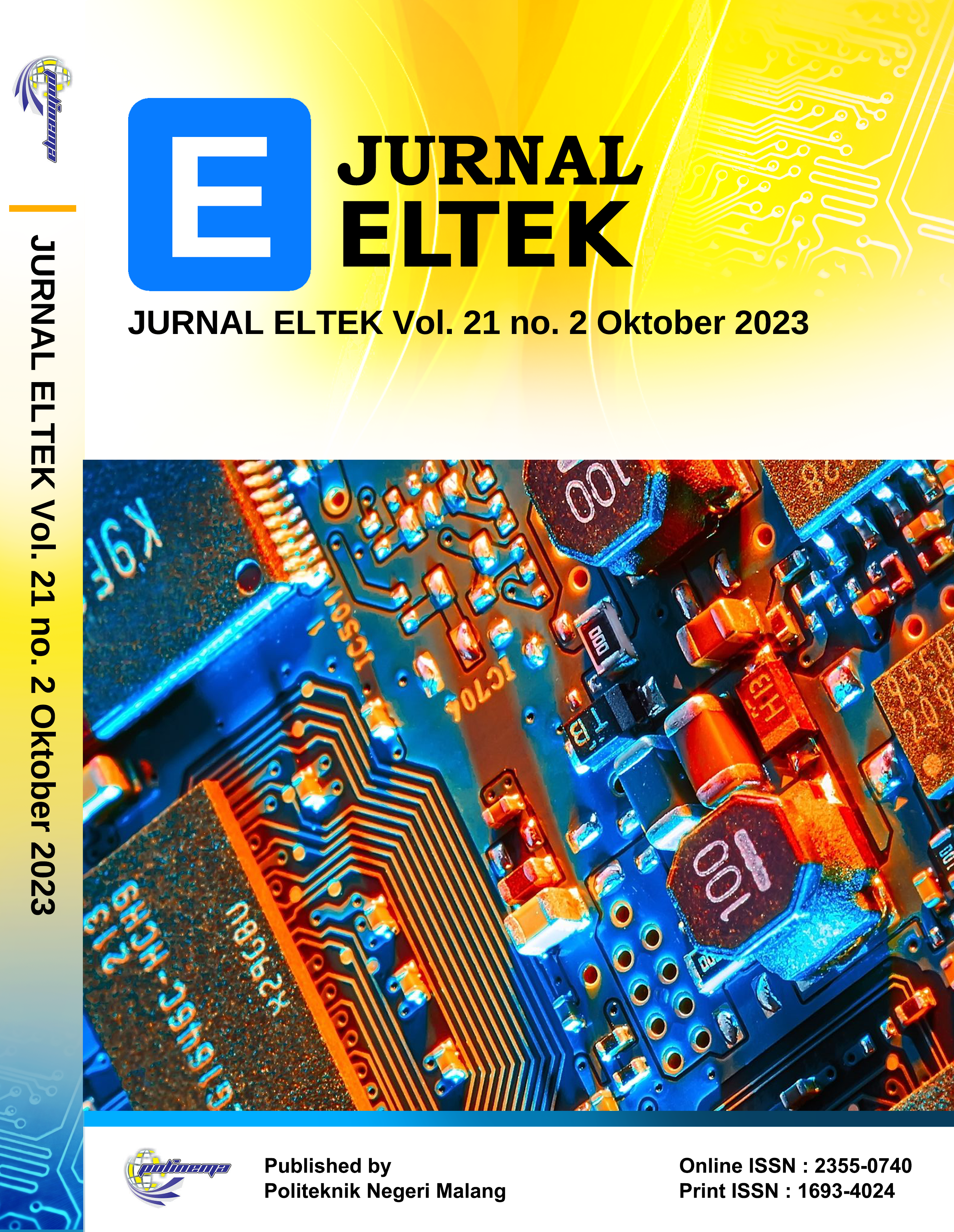Studi penyebab dan penanganan fail detection pada shinkawa vibration sensors unit circulating water pump di PT. X menggunakan metode root cause failure analysis
DOI:
https://doi.org/10.33795/eltek.v21i2.4610Keywords:
Circulating Water Pump, CiShinkawa Vibration Sensor, Root Cause Failure AnalysisAbstract
Circulating Water Pump merupakan salah satu equipment penting pada proses operasi di PT X. Oleh karena itu sistem permesinan harus dijaga dan dirawat dengan baik agar selalu dalam kondisi yang prima. Untuk meningkatkan kehandalan, sistem dipasang pendeteksi getaran yang akan membuat sistem menjadi trip untuk menghindari dari kerusakan yang fatal dengan memasang Shinkawa Vibration Sensor yang akan mendeteksi kerusakan bantalan yang dideteksi dengan adanya getaran berlebih. Prinsip kerja dari Shinkawa Vibration Sensor adalah dengan menggunakan Non-Contact Displacement Transducer yaitu dengan mengukur gap antara sensor dan bantalan. Pada artikel ini, sistem pendeteksi getaran mengalami fail detection, sistem trip tetapi semua peralatan dan bantalan dalam kondisi baik. Berdasarkan analisa menggunakan Root Cause Failure Analysis disimpulkan penyebabnya adalah adanya getaran akibat petir. Untuk itu dilakukan penanganan dengan setting ulang agar tidak terulang kembali
ABSTRACT
The Circulating Water Pump is one of the important equipment in the operational process at PT X. Therefore, the machinery system must be maintained properly so that it is always in prime condition. To increase reliability, a vibration detector is installed in the system which will trip the system to avoid fatal damage by installing a Shinkawa Vibration Sensor which will detect bearing damage which is detected by excessive vibration. The working principle of the Shinkawa Vibration Sensor is to use a Non-Contact Displacement Transducer, namely by measuring the gap between the sensor and the bearing. In this article, the vibration detection system experienced failed detection, the system tripped but all equipment and bearings were in good condition. Based on analysis using Root Cause Failure Analysis, it was concluded that the cause was vibrations caused by lightning. For this reason, handling is carried out by resetting so that it does not happen again.
References
N. K. Caturwati, Y. Yusuf, R. Rosyadi e M. I. A. F. Al Faiz, “Performance of Gas Turbine Cooling System (Radiator) at PLTGU XYZ against Environmental Air Temperature,” Jurnal Rekayasa Energi Manufaktur, vol. 5, nº 1, pp. 15 - 21, e-ISSN 25283723, 2020.
J. E. Hartanto e M. Tamjidillah, “Analisa Pengoperasian 1 CWP dan 2 CWP Pada Cooling Water System PLTU Asam Asam Unit 4,” SJME Kinematika, vol. 4, nº 2, pp. 37 - 52, 2019.
P. Yuliarty e Fachrurrozi, “Pemeliharaan Circulating Water Pumps Pada Pembangkit Listrik Tenaga Gas dan Uap (PLTGU) Blok 1 PT. Pembangkit Jawa Bali Unit Pembangkit Muara Karang,” Jurnal Ilmiah Teknik Industri, vol. 3, nº 2, pp. 102 - 109, 2015.
S. Nugroho, A. Hamid, G. D. Haryadi e Khaeroman, “Failure Analysis of Shaft Circulating Water Pump (CWP) used in Power Plant,” em MATEC Web of Conference, IJAEC & ISAMPE, DOI: 10.1051/matecconf/201815902027, Semarang, 2018.
P. Busono e S. Pujiarta, “Analisis Penyebab Terjadinya Vibrasi pompa Sistem Pendingin Sekunder PA-02 AP001,” Bulletin of Nuclear Reactor Management, vol. XVIII, nº 1, pp. 40 - 50, 2021.
F. R. Adi e Suwarmin, “Identifikasi Keausan Bantalan Tirus (Tapered Bearing) Berbasis Analisis Vibrasi dengan Metode Support Vector Machine (SVM),” Jurnal Teknik ITS, vol. 6, nº 2, pp. 2337-3520, 2017.
P. A. S. G. Adnyana, R. S. Hartati e ,. I. G. D. Arjana, “Rancang Bangun Data Logger Monitoring Vibrasi Pada Motor Listrik 6,3 KV Berbasis IOT Secara Real Time di PLTU Jeranjang,” Jurnal SPEKTRUM, vol. 9, nº 1, pp. 121 - 129, 2022.
D. Goyal e B. Pabla, “The Vibration Monitoring Methods and Signal Processing Techniques for Structural Health Monitoring: A Review,” Arch Computat Methods Eng 23, 585–594 (2016). https://doi.org/10.1007/s11831-015-9145-0, vol. 23, pp. 585–594, https://doi.org/10.1007/s11831-015-9145-0, 2016.
M. H. M. Ghazali e W. Rahiman, “Vibration Analysis for Machine Monitoring and Diagnosis: A Systematic Review,” Shock and Vibration, vol. 2021, pp. 1 -25, https://doi.org/10.1155/2021/9469318, 2021.
M. Tiboni, C. Remino, R. Bussola e C. Amici, “A Review on Vibration-Based Condition Monitoring of Rotating Machinery,” Applied Sciences, vol. 12, nº 972, p. DOI: 10.3390/app12030972, 2022.
R. J. Shipley, B. A. Miller e R. J. Parrington, “Introduction to Failure Analysis and Prevention,” Journal of Failure Analysis and Prevention, vol. 22, pp. 9 - 41, https://doi.org/10.1007/s11668-021-01324-2, 2022.
R. Subagyo e B. R. Hendratno, “Analisa Performance Pompa Sentrifugal di Unit 2 PT. Pupuk Kalimantan Timur,” ELEMEN (Jurnal Teknik Mesin), vol. 8, nº 1, pp. 30 - 38, 2021.
Omron , “Proximity Sensor,” Omron Industrial Automation, 10 October 2023. [Online]. Available: https://www.ia.omron.com/support/guide/41/explanation_of_terms.html. [Acesso em 10 October 2023].
M. Yazdi, J. Mohammadpour, H. Li, H.-Z. Huang, E. Zarei, R. G. Pirbalouti e S. Adumene, “Fault tree analysis improvements: A bibliometric analysis and literature review,” Quality and Reliability Engineering, p. DOI: 10.1002/qre.3271, 2023.
J. Bodhika, W. G. D. Dharmaratna, M. Fernando e V. Cooray, “A preliminary study on characteristics of thunder pulses of lightning,” em International Conference on Lightning Protection (ICLP), Shanghai, China, 2014.
Shinkawa, “FK-202F Non-Contact Displacement/Vibration Trnasducer,” Shinkawa Sensor Technology Inc., Japan, 2011.
Downloads
Published
How to Cite
Issue
Section
License
Copyright (c) 2023 Zidny Alfian Barik, Suka Handaja

This work is licensed under a Creative Commons Attribution-ShareAlike 4.0 International License.







